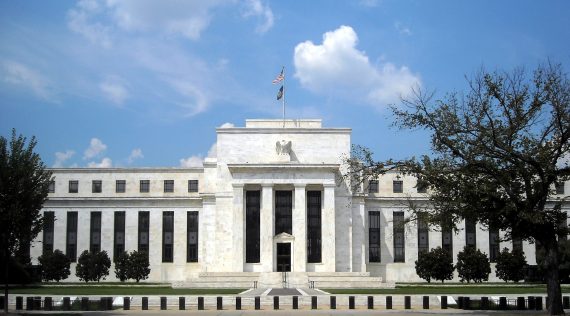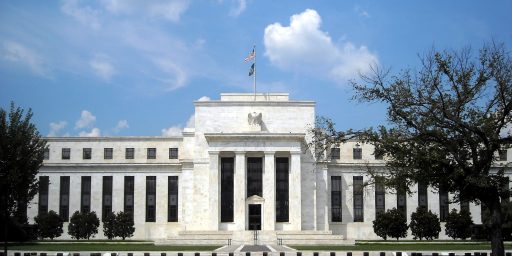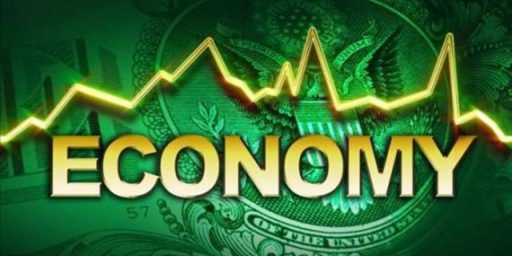Federal Reserve Raises Interest Rates For Third Time In Fifteen Months
For only the third time since the Great Recession ended, the Federal Reserve Board has raised interest rates.
For the second time in three months, but only the third time in the past ten years, the Federal Reserve Board has raised interest rates:
The Federal Reserve delivered the widely expected increase in its benchmark interest rate on Wednesday, and said the domestic economy remained on a path of slow and steady growth.
The decision raises the Fed’s benchmark rate to a range between 0.75 percent and 1 percent.
In a statement after a two-day meeting of its policy-making committee, the Fed said that the United States economy continued to chug along, expanding at a “moderate pace.” Employers are hiring, consumers are spending and businesses — the laggards in recent months — are starting to spend a little more, too.
The Fed also highlighted a recent increase in inflation after a long period of sluggishness. Prices are now rising at roughly the 2 percent annual pace that the Fed regards as optimal. The Fed, which had made faster inflation a central objective, said on Wednesday that it was now focused on stabilizing inflation.
It is the first time in recent years that the Fed’s forecasts have moved in the direction of tightening, a change in tune that parallels the Fed’s confident tone and its decision to raise rates on Wednesday.
There was one dissent. Neel Kashkari, president of the Federal Reserve Bank of Minneapolis, voted against raising interest rates. The Fed’s statement did not provide a reason for Mr. Kashkari’s vote.
The Fed’s assessment of economic conditions remained quite measured. There was no sign of the ebullient optimism President Trump had shown in recent comments about the economy.
A new round of economic projections from the Fed’s senior officials was nearly unchanged from the last round of projections in December. The Fed continues to forecast a Goldilocks economy, with the unemployment rate remaining at 4.5 percent and inflation around 2 percent for the next three years.
An increased number of Fed officials are expecting to raise rates at least twice more this year. Only three of the 17 officials who submitted forecasts now expect the central bank to move more slowly. There was a similar coalescing around tighter policy for the following two years, although the median prediction of a 3 percent funds rate by the end of 2019 remained unchanged.
The rate hike will increase the upward pressure on interest rates that consumers pay, but the immediate effect is likely to be modest. People with credit card debt are likely to see an immediate increase of about a quarter percentage point in their interest rates. The effect on longer-term loans is less direct, but the average rate on a 30-year mortgage rose by half a percentage point over the last year.
The nation’s largest borrower, the federal government, will also feel the pinch of higher rates. Federal interest payments, measured as a share of the economy, are expected to double over the next decade, according to the Congressional Budget Office.
Savers are unlikely to benefit immediately. Banks tend to raise interest rates on loans more quickly than they raise rates on deposits. That was certainly the pattern after the Fed last raised rates, in December. Last week, the average rate on a six-month certificate of deposit was 0.14 percent. Last year at this time: 0.13 percent.
Wednesday’s decision quickens the Fed’s march toward higher rates. The Fed raised rates for the first time since the financial crisis in December 2015. It waited a full year before the second hike. The third comes just three months later.
Wednesday’s decision quickens the Fed’s march toward higher rates. The Fed raised rates for the first time since the financial crisis in December 2015. It waited a full year before the second hike. The third comes just three months later.
One reason for that is that economic growth remains slow. The economy expanded by just 1.6 percent in 2016, and there is little sign of an acceleration during the first quarter. But the Fed has concluded that the economy is growing at something close to its maximum sustainable pace.
As I noted when I wrote about last Friday’s Jobs Report, all the signs were there to indicate that the Fed would raise rates today, something with Board Chair Janet Yellen hinted at quite strongly at the end of the month. Jobs growth is averaging a fairly strong number, albeit not one that I’d call spectacular. Economic growth is averaging around two to two-and-a-half percent a year, which is better than much of the rest of the First World even though it makes the recovery from the Great Recession the weakest such recovery since the end of World War Two, and current economic statistics indicate that we’re likely to continue on this path for the foreseeable future. Additionally, the fact that interest rates were near zero, and effectively at zero when adjusted for inflation, for so long that the Federal Reserve had very few tools available to it going forward. The one that it did have largely didn’t do much to stimulate the economy beyond increase the incentive to invest in stocks by keeping interest rates for Federal debt and other bonds at historically low levels, and that doesn’t really have much impact on the broader economy at all. Finally, the increase is a relatively modest one-quarter of one percent, the same amount as the previous two increases, neither one of which appear to have had a serious negative impact on economic growth, which is the biggest risk from rising interest rates.
In any case, with this action it does appear that the Federal Reserve is committed to a more frequent rise in rates than we’ve seen in the past, at least for the time being. Given the fact that we haven’t even reached the point yet where the Fed has raised rates one percent from where they were prior to December 2015. Unless economic forecasts start taking an unexpected dip, or events elsewhere in the world indicate an increased risk of uncertainty in the economy or the financial markets, it’s likely we’ll see additional increases in the months to come, most likely on the quarterly basis that the Federal Reserve has mentioned in the past. This would put the next probable increase in June, possibly followed by additional such increases in September and December. What will be interesting to see is what impact if any all of this has on fiscal policy from Congress and President Trump. Higher interest rates do mean that the costs of Federal borrowing will inevitably increase, and we’re already at the point where it’s projected that the national debt will more than double if Trump gets everything he claims he wants. If interest rates increase significantly, the increase is likely to be higher than that, and that will have an impact on the ability of the Federal Government to spend money. Additionally, such an increase in the national debt is likely to cause problems among Republicans as it will renew the debate between the deficit hawks and others in the GOP caucus in both the House and the Senate.





Obviously Obama left the economy in a complete mess, otherwise why would they raise interest rates?
Oh…wait…never mind…
As I snarked in your jobs post, wages are showing small signs of rising and the Fed isn’t going to put up with that shit for very long. On the other hand, it’s obvious that the policies of both Trump and the Congressional GOPs are going to be inflationary and it probably makes sense for the Fed to try to get a little ahead of the game.
OT, but has anyone seen the horrible hairball that the West Virginia politicians just coughed up as a present for the coal mining companies?
What it basically boils down to “get used to mining disasters, you mineworkers. So what if you die if the mining companies can make more ca$h by getting rid of 90% of safety regulation?”
Yessiree, that’s how you get your coal-mining jobs back, boys!
(I call them “Trump’s Chumps.” )
I’m sure someone with more authority than me will soon come along to expand on this but the Trump/Ryan budget that will be unveiled in the next month or two is based on exactly the opposite assumptions. There are sure to be significant tax cuts and it’s been promised that there will be stimulus. As the last paragraph of the Original Post mentions there will be escalating costs of borrowing by the U.S. Gov’t. So we will once again have a Republican administration that runs the federal deficit to the moon after spending 8 yrs blasting the spendthrift Dem’s for saddling our children with trillions in debt. In vox-dot-com today, Jim Tankersley explains how we might see a Dr Doolittle style ‘PushmePullyou’ in the near future.
We are all shocked, I know.
@grumpy realist:
I guess that’s “isn’t sure” as in “well, we didn’t really want a bill that gutted regulations, but since you’re really determined to force it on us…”
@gVOR08: I have been amazed how this Federal Reserve always seems to do what it wants. Where the checks and balances here ?
Now because of these recent increases, I am getting 7 – 10 calls a day begging me to refinance, which I did about a year and a half ago. Thanks a lot, Mrs Yellen.
“A little bit here and a little bit there, it starts to add up”
@JohnMcC:
On another thread we’ve been talking about how conservatives are rigid thinkers. Back when we needed it, they wouldn’t allow fiscal stimulus. Now that the black guy won’t benefit, they’re all in favor of it. The funny thing (well, ironic) is that it won’t work. It only works when interest rates are at the zero lower bound. The economy is porked.
Well, it would be ironic if they actually believed any of what they’re saying. It’s really – We’re gonna cut taxes and raise spending. How the hell do we justify that after we bitched about deficits for eight years?……Umh….Er…Stimulus! That’s the ticket. We’re doing stimulus!
@gVOR08: Well said. One could use Mr Google’s Magic Machine to learn the growth and retreat of the federal deficit year by year and compare that information to presidential terms. The data would be muddled by the coming and going of congressional majorities. But I assure you that the R-party would never again seem like serious budget hawks to you.
Ask your Republican friends/family ‘who were the last two Presidents to present a balanced budget to Congress’. You’ll win a lot of drinks. Bill Clinton and Lyndon Johnson.
OT, but a federal district judge in Hawaii issued a nationwide TRO this evening blocking implementation of Trump’s replacement immigration EO.
Let the games begin 🙂
@HarvardLaw92: On First Amendment, not procedural, grounds. Fun times.
@gVOR08: The Federal Reserve isn’t getting ahead of anything. It’s making inflation worse.
@Ben Wolf: Care to elaborate?
@Ben Wolf: But, but, BO said the economy is doing great…Fed is behind, they are following bonds.